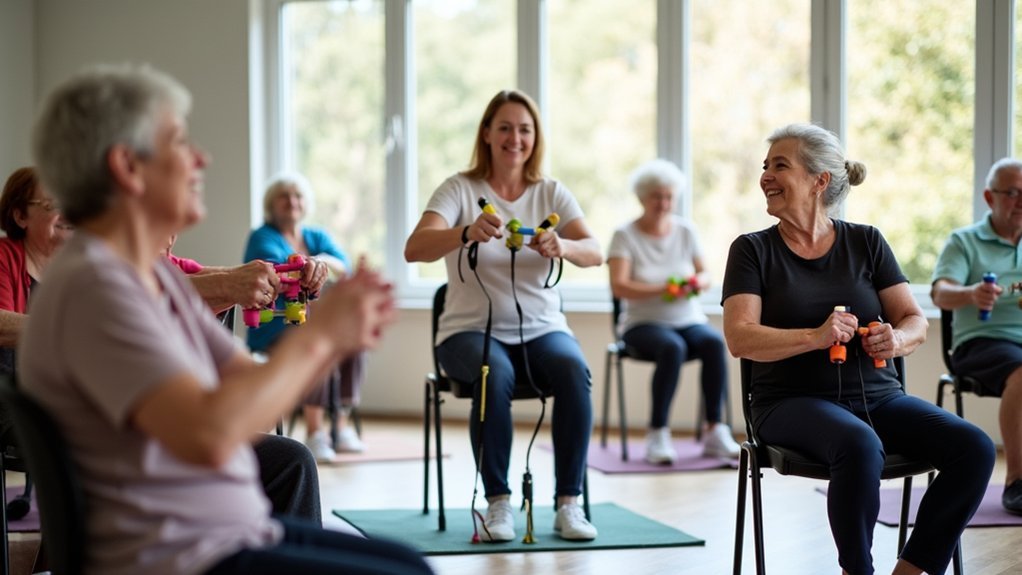Pediatricians recommend age-appropriate bouncy activities with strict safety guidelines. For children under six, consider gentle bouncing on laps or mini-trampolines with supervision. Older kids can use full-size trampolines with safety nets and padding. Limit sessions to 30 minutes daily, broken into shorter intervals. Bouncing develops motor skills, improves balance, and strengthens muscles while releasing mood-enhancing endorphins. The right bouncy routine can transform your child’s physical development and emotional well-being.
Age-Appropriate Bouncy Activities for Optimal Development

While many parents focus on structured sports and academic skills, pediatricians increasingly recommend bouncy exercises as vital components of childhood development. These activities stimulate the vestibular system, essential for balance and body awareness during early developmental stages.
For infants and toddlers, gentle bouncing on your lap or supervised mini-trampolines helps initiate muscle development.
Preschoolers benefit from animal jumps—hopping like frogs or rabbits—which enhance gross motor skills and coordination.
Elementary-aged children can progress to more challenging activities like jumping over “laser beams” (string or tape) or incorporating light weights for strength building.
These bouncy activities align with pediatric therapy recommendations, providing valuable sensory input while making physical activity enjoyable.
For children with sensory processing challenges, regular bouncing can greatly improve emotional regulation and body awareness.
Safety Guidelines for Trampoline and Rebounding Exercise
Because trampolines can pose significant injury risks when used improperly, safety must be your top priority when introducing bouncy exercise to children.
Prioritize safety first when introducing trampolines to children—their fun should never compromise protection.
Always verify adult supervision during trampoline activities and equip the equipment with proper safety nets and padding to prevent falls and injuries.
Children under six shouldn’t use trampolines, as they’re at higher risk for injuries compared to older children.
Allow only one child at a time on the trampoline to avoid collisions, which are a common cause of accidents.
Create a safe play environment by regularly inspecting the trampoline for wear and tear.
Check that springs are covered, padding is intact, and the safety net is secure.
Following these safety guidelines will help your children enjoy trampolines while minimizing potential risks.
Health Benefits of Supervised Bouncing for Children

Supervised bouncing activities offer children numerous physical and mental health benefits that extend far beyond simple play.
When your child engages in trampoline or other bouncing exercises, they’re developing essential gross motor skills and improving coordination that contribute to their overall physical development.
These activities stimulate your child’s vestibular system, enhancing balance and spatial awareness while strengthening muscles. You’ll notice improved cardiovascular fitness as regular bouncing strengthens their heart and builds endurance.
Beyond physical advantages, supervised bouncing positively impacts mental well-being by releasing mood-boosting endorphins that reduce anxiety and improve emotional regulation.
Recommended Duration and Frequency of Rebounding Sessions
Although excitement often leads to extended play sessions, pediatricians recommend specific durations and frequencies for children’s rebounding activities. The ideal recommended duration is 30 minutes daily, but you’ll find greater success breaking this into 10-15 minute intervals to maintain your child’s interest and energy.
For infants and toddlers, start with just 5-10 minutes, gradually increasing as their coordination and stamina develop. Aim for consistent rebounding sessions 3-5 times weekly to maximize benefits for physical development, including improved cardiovascular fitness, muscle strength, and coordination.
You’ll want to incorporate variety in these bouncing activities to keep children engaged while ensuring safety. This structured approach to rebounding sessions follows pediatricians’ guidance for supporting overall health through active play.
Integrating Bouncy Exercise Into Family Fitness Routines

Family-centered rebounding activities deliver benefits beyond individual sessions, transforming everyday routines into opportunities for health and connection.
You can easily incorporate bouncy activities into your family fitness strategy by scheduling 30-minute trampoline sessions several times weekly. These energetic workouts improve cardiovascular health while developing strength and balance for everyone.
Trampoline exercises create the perfect environment for children to enhance their motor skills through active play.
When you bounce together, you’re not just burning calories—you’re building lasting memories and establishing healthy habits that combat sedentary behaviors.
Frequently Asked Questions
How Can I Help My Baby Bounce?
Help your baby bounce by using a baby bouncer, holding them for gentle bouncing, playing knee-bouncing games, trying infant-appropriate trampolines, and keeping sessions short to prevent overstimulation while building their motor skills.
Who Recommended Exercise for Children?
The American Academy of Pediatrics and World Health Organization recommend exercise for children. You’ll find they advocate for 60 minutes of daily physical activity to support healthy development and prevent childhood obesity.
What Exercises Are Good for Low Tone Babies?
For low tone babies, you’ll find tummy time, gentle resistance exercises, “weight lifting” with toys, and bouncing activities most beneficial. Aim for 30 minutes daily to improve muscle strength and coordination in your infant.
What Exercises Help Babies Sit Up?
You’ll help your baby develop sitting skills through assisted sit-ups, tummy time, and supported sitting practice. Pull them gently to sitting position, offer toys during tummy time, and make it fun with smiles and engagement.
In Summary
You’ll find that bouncy exercise offers tremendous benefits for your child when done safely. Follow your pediatrician’s guidelines about age-appropriate activities, proper supervision, and time limits. By incorporating trampolines, exercise balls, or rebounders into family routines, you’re not just making fitness fun—you’re supporting your child’s coordination, strength, and cardiovascular health. Always prioritize safety features and adult supervision during these energetic activities.





Leave a Reply